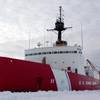This Day in Coast Guard History – May 6
1796-Congress increased the monthly compensation of Revenue Marine officers: masters $50; first mates $35; second mates $30; third mates $25 and mariners $20.
1896-President Grover Cleveland placed the Lighthouse Service within the classified federal civil service.
1898-The cutter Morrill participated in an engagement at Havana, Cuba on 6 and 7 May 1898 during the Spanish-American War. Her officers were awarded Bronze Medals by the authority of a joint resolution of Congress that was approved on 3 March 1901.
1945-The Coast Guard-manned frigate USS Moberly (PF-63), in concert with USS Atherton, sank the U-853 in the Atlantic off Block Island. There were no survivors.
1958-During her 50 plus year career, the Huron Lightship WAL-526 at Port Huron, Michigan, survived many a Great Lakes storm without the loss of a single crewmember until that date in 1958 when Seaman (Boatswain Mate Striker) Robert G. Gullickson lost his life while attempting to swim for assistance to save another shipmate, CS1 Vincent Disch, after their small boat was swamped by a freighter's wake and sank. Disch was rescued but Gullickson was lost at sea and his remains were never recovered. Gullickson was posthumously promoted to BM3 for his rescue attempt and for sacrificing his life for his shipmate.
1994- The last HH-3F Pelican helicopter in Coast Guard service was retired. This ended the Coast Guard's "amphibious era," as no aviation asset left in service was capable of making water landings.
2003-Cutter Walnut completed its 20-day humanitarian mission in support of Operation Iraqi Freedom of marking the navigational channel of the Khawr Abd Allah waterway leading from the North Arabian Gulf to Iraq’s critical port of Umm Qasr. The Walnut completely replaced 30 buoys and repaired an additional five along the 41-mile waterway, vastly improving the navigational safety of the waterway for humanitarian aid sailing to the port and providing a critical step towards the economic recovery of the people of Iraq. The majority of the equipment used in the navigational improvements was located in a warehouse in Umm Qasr and was inspected and upgraded to ensure that the buoys matched as closely as possible to the charted channel. The Walnut was originally deployed to the North Arabian Gulf with an oil spill recovery system in the event the regime of Saddam Hussein committed any acts of environmental terrorism. When those threats did not materialize the cutter conducted maritime interdiction operations enforcing U.N. Security Council resolutions, participated in the search for two downed United Kingdom helicopters, and patrolled and provided assistance to captured Iraqi offshore oil terminals.
(Source: USCG Historian’s Office)










